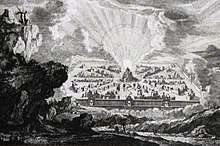New Earth (Christianity)
The New Earth is an expression used in the Book of Isaiah (65:17 & 66:22), 2 Peter (3:13), and the Book of Revelation (21:1) in the Bible to describe the final state of redeemed humanity. It is one of the central doctrines of Christian eschatology and is referred to in the Nicene Creed as the world to come.

Biblical references
The twenty-first chapter of the Book of Revelation introduces the final state of perfection where, according to one commentator, "cosmic time has been turned into eternity."[1] In symbolic and visual language, God allows John to see the glory and beauty of the inheritance of His people. The first thing the reader notices about this vision is that it includes a "new heavens and a new earth" (21:1). To understand what the Bible teaches about eternity, the reader of the Apocalypse must understand the New Testament doctrine of the "New Heavens and the New Earth."[2]
The basic difference with the promises of the Old Testament is that in Revelation they also have an ontological value (Rev. 21:1;4: "Then I saw 'a new heaven and a new earth,' for the first heaven and the first earth had passed away, and there was no longer any sea...'He will wipe every tear from their eyes. There will be no more death' or mourning or crying or pain, for the old order of things has passed away") and no longer just gnosiological (Isaiah 65:17: "See, I will create/new heavens and a new earth./The former things will not be remembered,/nor will they come to mind").[3][4]
But, in accordance with his promise, we wait for new heavens and a new earth, where righteousness is at home (2 Peter 3:13).
Interpretation
In Koine Greek, there were two words that are translated as "new" in the English Bible; neos and kainos. One Greek resource states:
As distinct from néos, "new in time," kainós means "new in nature" (with an implication of "better"). Both words suggest "unfamiliar," "unexpected," "wonderful," and the distinction fades with time.[5]
That kainos should not be taken as something totally new can be seen in a passage like the following:
If anyone is in Christ, there is a new creation: everything old has passed away; see, everything has become new! (2 Corinthians 5:17)
Here the Apostle Paul uses kainos in the expression "new creation." Paul did not intend to convey the idea that this is a completely different individual. There is continuity between the old person and the new person to such an extent that it remains the same person, but renovated. The person is the same, but the quality of that person has been transformed.
In the same way, the biblical concept of the New Earth is one of renovation and restoration. Either on this current earth or on a rebuilt new planet. This conclusion is supported by Peter's words in his public speech in the temple at Jerusalem.
Repent and return, so that your sins may be wiped away, in order that times of refreshing may come from the presence of the Lord; and that he may send Jesus, the Christ appointed for you, whom heaven must receive until the period of the restoration of all things about which God spoke by the mouth of His holy prophets from ancient time.[6]
This earth, however, will be either cleansed or destroyed by fire for the purpose of restoration as expressed in the following passage:
But the day of the Lord will come like a thief, and then the heavens will pass away with a loud noise, and the elements will be dissolved with fire, and the earth and everything that is done on it will be disclosed. Since all these things are to be dissolved in this way, what sort of persons ought you to be in leading lives of holiness and godliness, waiting for and hastening the coming of the day of God, because of which the heavens will be set ablaze and dissolved, and the elements will melt with fire? (2 Peter 3:10-12)
See also
References
- Simon J. Kistemaker, Exposition of the Book of Revelation (New Testament Commentary; Grand Rapids: Baker Book House, 2001), 554.
- Jack Cottrell, The Faith Once for All: Bible Doctrine for Today (Joplin, Mo.: College Press Pub., 2002), 564–572; David Martyn Lloyd-Jones, The Church and the Last Things (Wheaton, Ill.: Crossway Books, 1998), 246–248; G. C. Berkouwer, The Return of Christ (Grand Rapids: Eerdmans, 1972), 210-234.
- Joel B. Green; Jacqueline Lapsley; Rebekah Miles; Allen Verhey, eds. (2011). Dictionary of Scripture and Ethics. Ada Township, Michigan: Baker Books. p. 190. ISBN 1-44123998-7. ISBN 978-1-441-23998-3.
This goodness theme is advanced most definitively through the promise of a renewal of all creation, a hope present in OT prophetic literature (Isaiah 65:17–25) but portrayed most strikingly through Revelation's vision of a "new heaven and a new earth" (Revelation 21:1). There the divine king of creation promises to renew all of reality: “See, I am making all things new” (Revelation 21:5).
- Steve Moyise; Maarten J.J. Menken, eds. (2005). Isaiah in the New Testament. The New Testament and the Scriptures of Israel. London: Bloomsbury Publishing. p. 201. ISBN 0-56761166-3. ISBN 978-0-567-61166-6.
By alluding to the new Creation prophecy of Isaiah John emphasizes the qualitatively new state of affairs that will exist at God's new creative act. In addition to the passing of the former heaven and earth, John also asserts that the sea was no more in 21:1c.
- G. Kittel, G. Friedrich, G. W. Bromiley (1995, c1985). Theological Dictionary of the New Testament. Translation of: Theologisches Wörterbuch zum Neuen Testament (Grand Rapids, Mich.: W. B. Eerdmans), 388.
- Acts 3:19-21